Raisin Scones – English Scones
I can guarantee you that this is an authentic English Scone recipe. I used this recipe for 7 years when I worked in a British tea shop. I got the personal approval of the owner’s British mom for my Raisin Scones.
If you’re looking for a recipe for plain scones, you can follow this recipe and just leave out the raisins.
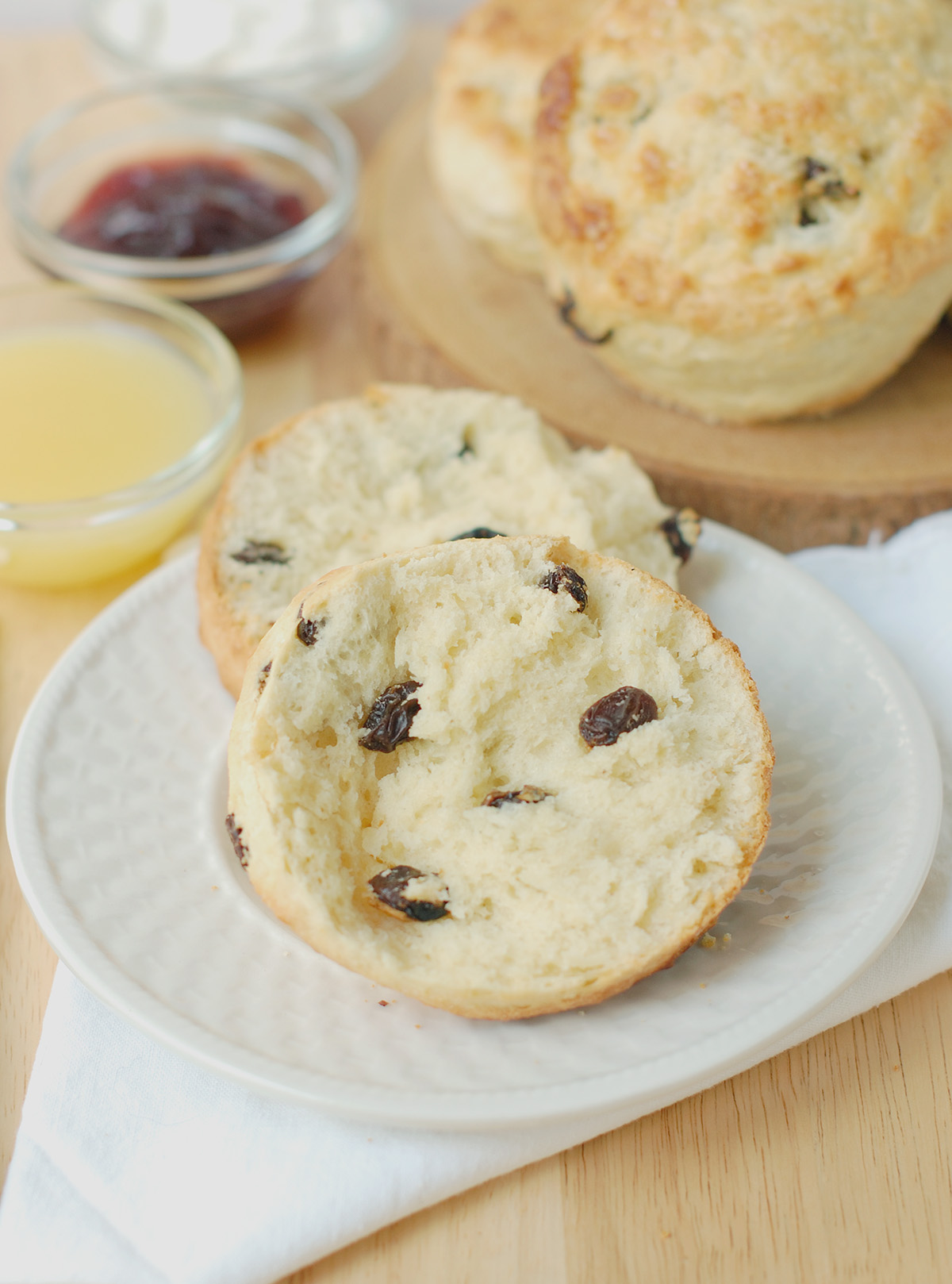
An authentic English Scone Recipe
I see lots of bad scones in coffee shops and bake shops. Most of the time they’re so light and sweet they’re closer to a muffin than a scone.
A good English scone should neither be too biscuit-like nor too muffin-like, but should fall somewhere between the two.
I worked at a British Tea Shop for 7 years. Over that time and in my career since I’ve baked, literally, tens of thousands of scones.
This Raisin Scone recipe is adapted from one given to me by the shop owner’s British mum.
I made adjustments to the original recipe so it could work in a US kitchen with US ingredients and measurements. I can tell you I get great feedback from everyone who tastes these scones.
Ingredients
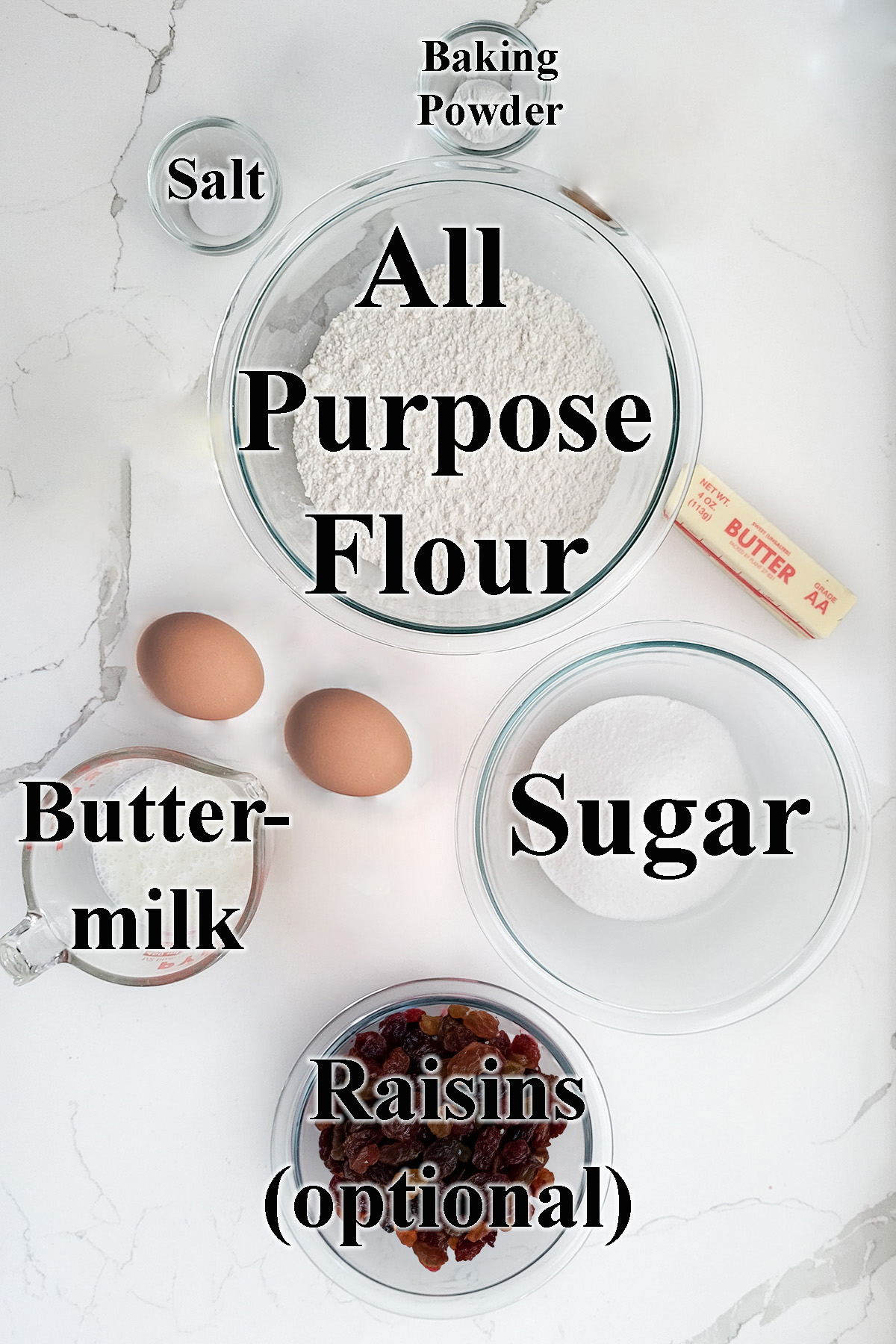
Ingredient Notes
- All purpose flour – Medium protein all purpose flour makes a scone that has enough structure to rise high in the oven, but also has a tender crumb.
- Buttermilk – Acidic buttermilk tenderizes and flavors the scones. If you don’t have fresh buttermilk, buttermilk powder is the best substitute.
- Sugar – Just enough sugar is added to lightly sweeten and tenderize the dough.
- Raisins – The raisins are optional.
The Process for making English Scones
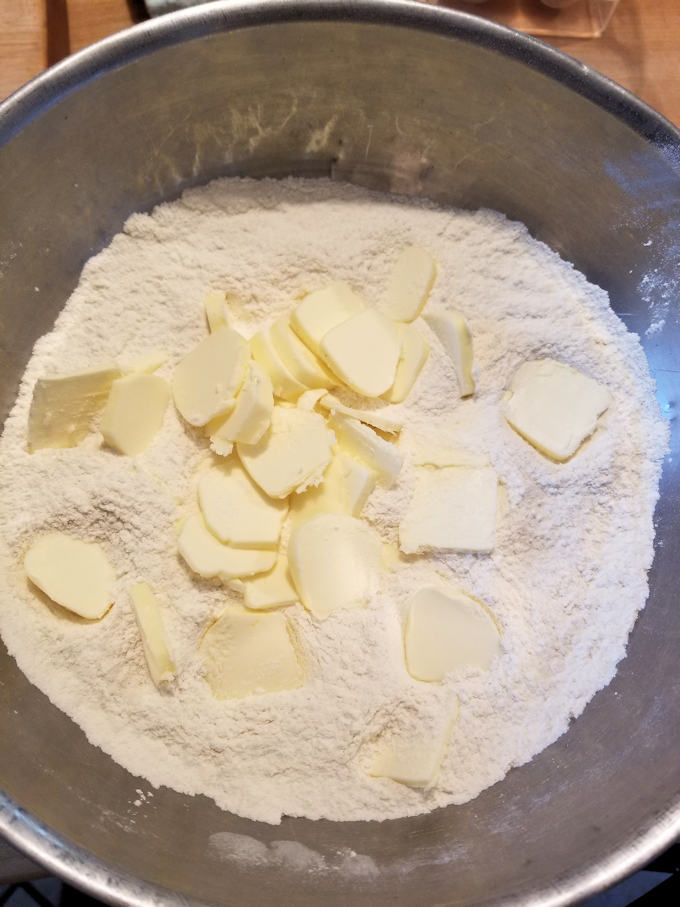
- Whisk together the dry ingredients in a large mixing bowl.
- Use your hands to work the butter into the dry ingredients until there are no bits larger than a pea.
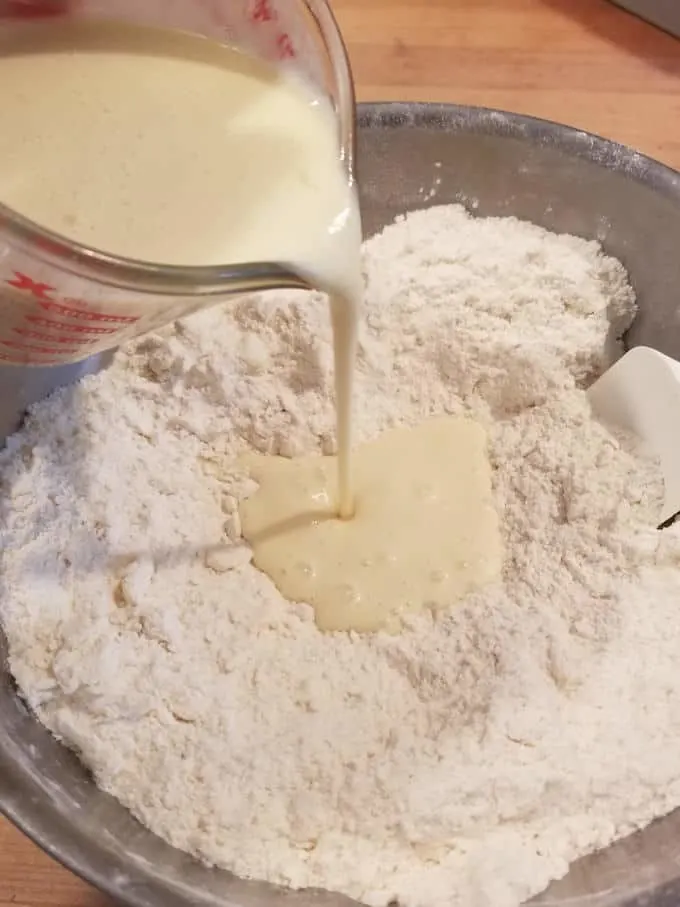
- Pour the buttermilk mixture into the flour base.
- Mix together until the flour and milk are about 2/3 combined.
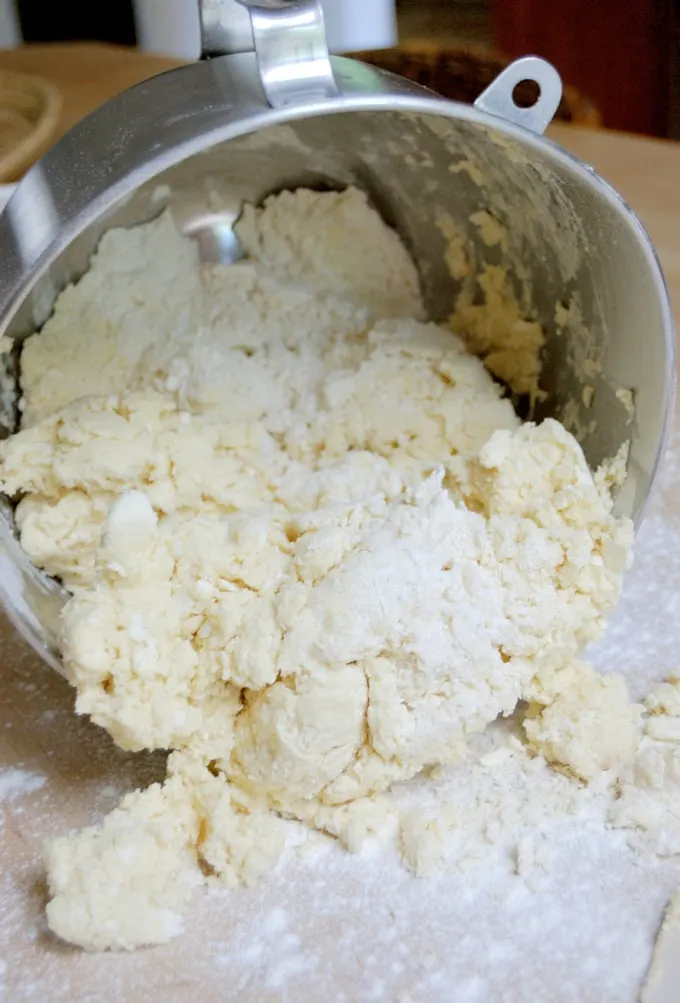
- Turn the dough out onto a floured surface. If you are using raisins, sprinkle them over the dough.
- Knead a couple of times to bring the dough together. As soon as all the flour is absorbed, stop kneading.
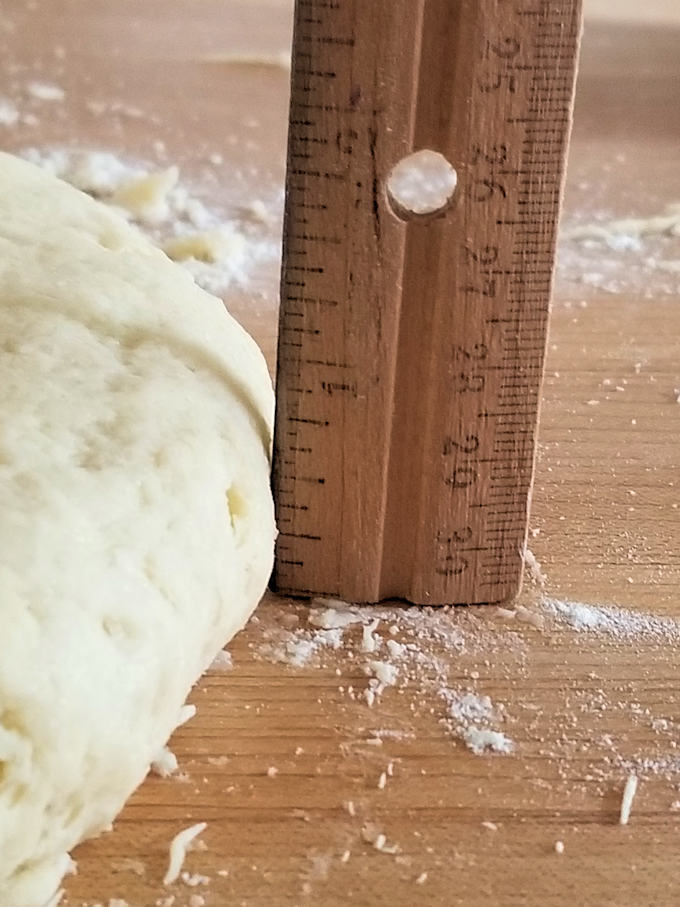
- Use your hands to pat the dough to 3/4″-1″ thick and cut rounds with a biscuit cutter.
- Reroll the scraps and continue cutting to use all the dough.
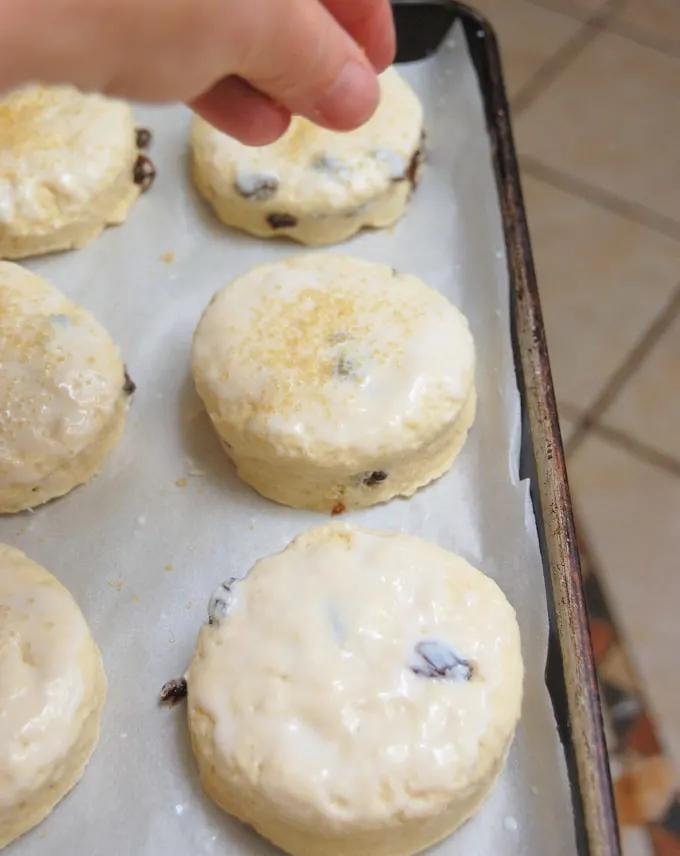
- Line the scones onto a parchment lined pan.
- Brush the scones with buttermilk and sprinkle with sugar.
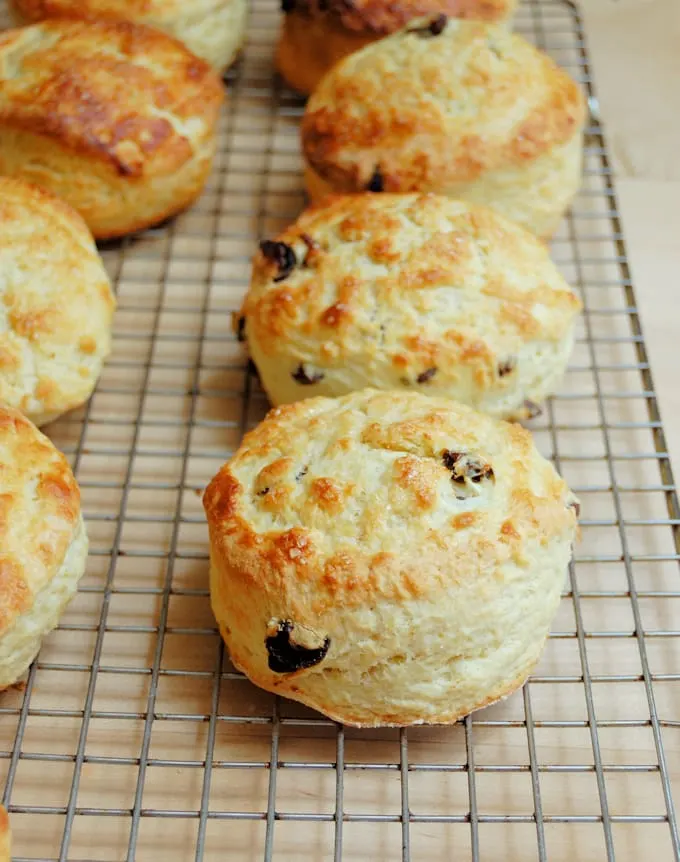
- Bake until golden brown.
Recipe Tips
- Use fresh buttermilk for this recipe. The tangy flavor and tenderizing acidity of the buttermilk make the best scones.
- Pat the dough out by hand instead of using a rolling pin to ensure the dough won’t be over worked. The dough can be made with a mixer but is easily done by hand.
Storage
Scones are best the day they are baked but will keep for 1-2 days at room temperature. Scones can be packed into bags and frozen for up to a month. Warm the scones in a 200F oven to revive the texture.
How to set up a full Afternoon Tea
- You can either arrange the components on separate serving plates or use a 3 tier dessert stand.
- For the first course serve dainty tea sandwiches. These should be placed on the bottom tier of the stand.
- Place the scones with clotted cream, lemon curd and preserves on the second tier.
- Small fancy pastries and cookies go on the top tier. Shortbread, Petite Fours and Bakewell Tart are perfect for afternoon tea.
But don’t wait until you plan a tea party to make scones. They are quick enough to make for weekend breakfast. Top them with butter or a little jam for a perfect breakfast or snack.

English Scones Recipe
Ingredients
- 25 oz unbleached all purpose flour (5 cups, see note)
- 2 tablespoons baking powder
- 4 oz granulated sugar (½ cup)
- ½ teaspoon table salt
- 6 oz unsalted butter (cold, cut into 1″ chunks)
- 2 large eggs
- 14 oz buttermilk (1 ¾ cups)
- 4 oz raisins (¾ cup, optional)
- Demerara Sugar for sprinkling
Instructions
- Preheat the oven to 375 °F. Line two ½ sheet pans with parchment paper or a silicone baking mat.
- In a large mixing bowl, whisk together 25 oz unbleached all purpose flour, 2 tablespoons baking powder, 4 oz granulated sugar and ½ teaspoon table salt. Toss in 6 oz unsalted butter chunks. Mix in the butter until the bits are the size of a pea.
- Whisk together 14 oz buttermilk and 2 large eggs. Add the buttermilk mixture to the dry ingredients all at once and mix until just barely combined. Some loose flour may remain at the bottom of the bowl. DON'T OVER MIX.
- Dump the dough onto a floured surface. If using, sprinkle 4 oz raisins over the dough. Finish kneading by hand just until all the loose flour is absorbed. Use your hands to pat the dough until it is ¾"-1" thick. Use a 2 ½-3" biscuit cutter to cut scones. Re-roll the scraps and continue cutting until all the dough is used.
- Line the scones onto the prepared baking sheet, leaving 1" space between. Brush the tops of the scones with buttermilk and sprinkle with Demerarra or granulated sugar.
- Bake on the middle racks of the oven, flipping the trays after 10 minutes (see note).
- The scones are ready when they are golden brown and sound hollow when the bottom is tapped. Total baking time 15-20 minutes.
Would you like to save this recipe?
As an Amazon Associate and member of other affiliate programs, I earn from qualifying purchases.


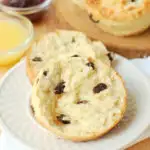

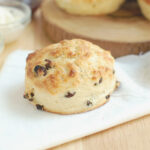





I’m going to make this recipe soon. Are the scones very crumbly ike so many other recipes I’ve tried?
Nope, I don’t post recipes until I’m very happy with the results. The texture is somewhere between a biscuit and a muffin, soft but not cakey.
Dear Eileen, the scones look perfect! I was wondering one thing though – I found many scone recipes being made without eggs (that’s actually how I make them – using only flour, butter and milk or buttermilk with extras and flavourings) and, on the other hand, many using eggs. Would you say the addition of eggs makes them richer tasting or does it affect their crumb? Is there “a rule” to making THE scone? Because I find my recipe gives me a delicious scone, but I am open-minded to try a variation. Thank you!
Hi Mirta. I adapted this recipe from one given to me by a British grandma, so I’m guessing it’s fairly authentic. But beyond that, the eggs do change the texture. Without the egg I think scones have more of a biscuit texture, kind of flakey and bready. With eggs then have a slightly more cakey and open crumb, but not as cakey as a muffin. As I say in the post, I like scones that are somewhere between a biscuit and a muffin. I think the egg helps get that texture.
Your photo of the split open scone is so mouth-watering! When you work in the raisins, are you just mixing with no “folding”? The British tea house here makes scones that split open, quite like a biscuit, and yours looks like they do, too.
Hi Holly. I don’t “fold” the dough. Once the buttermilk goes in I handle the dough as little as possible to keep them very tender. For that photo I didn’t cut the scone with a knife. Rather I used a fork to split it open so it has the craggly surface.
Just made these and the mix was so wet it was like cake batter… not kneadable. What texture should this be
The texture should be a wet dough, not at all like a cake batter. You can see in the photo where I’m dumping the dough out of the bowl what it should look like. Did you make any ingredient substitutions?
Would cream work instead of buttermilk?
Hi Sue, Cream would not be the same since it doesn’t have the acidity of flavor of buttermilk. The best substitutions would be either powdered buttermilk or use 1 3/4 cups whole milk with a tablespoon and 2 teaspoons of lemon juice or white vinegar mixed into the milk.
Thank you!